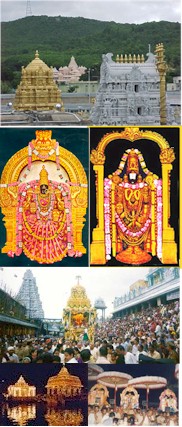Welcome to Adiyen Sri Ramanuja Dasan !
" Srimathe Ramanujaya Namaha !"
(62. Q. Contd...) The puranic concept on the origin of the holy shrine is shrouded in a mist of legends. Lengthy account of the sthalamahatyam is contained in as many as ten out of eighteen puranas. Sri Venkatachala Mahatyam figures in Sri Varaha, Padma, Garuda, Brahma, Markandeya, Vamana, Brahmanda, Skanda, Aditya and Bhavishyottara puranas.
When Dwapura yuga ended and Kaliyuga began Lord Maha Vishnu manifested in the form of Lord Venkateswara on the Vengadam hills. The Lord revealed in the Archavatara i.e. in the finite human idol form.
According to Bhavishyottara purana during the reign of emperor Tondaiman, certain cowherds noticed that a cow belonging to the royal goshala, while grazing on the hill, used to go upto a mound, emptied its udder at a particular anthill and returned home with an empty udder, the strange happening was reported to the king.
Later, the particular anthill under a tamarind tree, on the banks of Swami Pushkarini was opened up. They were amazed, when they discovered the Lord's swayam vyakta murti. A mandapam perhaps one room temple was built thereon. Sun and moon illumined the deity as there was no roof. However, the present temple made up of cutstone with garbhalaya and ardhamandapam can be dated to 8th or 9th century A.D.
The Lord i.e. the Mulaberam atop the hill in the form of an icon is swayam vyakta meaning a selfincarnate one. It was neither made by human hand nor consecrated by mortals, as the Murti swarupam is not according to the specifications envisaged in the Agama samhitas. Obviously the Mulaberam belongs to an earlier age than that of the Agamas.
The Lord revealed in the form of an Archavatara meaning in the finite human idol form for the benefit of lay men to enable them to concentrate and meditate on the supreme, which will eventually release them from the vicious cycle of birth and death.
It is the first Vaikhanasa Priest by name Gopinatha Deekshitulu, who first found the anthill under a tamarind tree where the idol of Lord Venkateswara found. Then he decided to perform worship to this idol with able assistance by a pot maker Rangadasa, who, in his next incarnation born as the king Tondaman.
This Rangadasa built a four pillared mantapam for the idol. Here if we examine the reference of Vaishnavaite Alwars (6th - 15th century A.D.), the first few in their pasurams (songs) have sung that the sunrays and rain is affecting the idol that means at that time the idol was there under an open mantapam. And in the next coming Alwars explained that the idol is present inside a sanctum surrounded by four walls.
King Tomdaman, as ordered by Lord Venkateswara, built the temple with first prakaram(Vimana Prakaram). Then the second prakaram was built by the rulers of Vijayanagar Kingdom(15th century A.D.)
Jai Srimannaryana !
Thanks for your valuable time. Visit our web site again for more information and latest updates.

